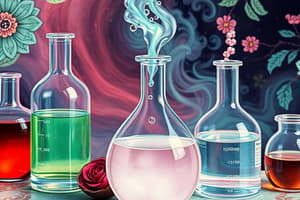Podcast
Questions and Answers
What is the characteristic of an acid that involves litmus paper?
What is the characteristic of an acid that involves litmus paper?
- It changes the smell of litmus paper
- It turns red litmus paper blue
- It turns blue litmus paper red (correct)
- It leaves litmus paper unaffected
What is the pH range of a base?
What is the pH range of a base?
- pH < 7
- pH > 7 (correct)
- pH = 7
- pH = 0
What type of reaction involves the transfer of electrons?
What type of reaction involves the transfer of electrons?
- Decomposition reaction
- Oxidation-reduction reaction (correct)
- Displacement reaction
- Combination reaction
What is the formula for calculating pH?
What is the formula for calculating pH?
What is the definition of a base?
What is the definition of a base?
What is a characteristic of metals?
What is a characteristic of metals?
What is an example of a decomposition reaction?
What is an example of a decomposition reaction?
What is the term for a series of metals arranged in order of their reactivity?
What is the term for a series of metals arranged in order of their reactivity?
What is an example of an acid?
What is an example of an acid?
What is a characteristic of non-metals?
What is a characteristic of non-metals?
Flashcards are hidden until you start studying
Study Notes
Acids and Bases
Acids
- Definition: A substance that donates a proton (H+ ion)
- Characteristics:
- Turn blue litmus paper red
- Conduct electricity
- Have a pH less than 7
- React with metals to produce hydrogen gas
- Examples: HCl (hydrochloric acid), H2SO4 (sulfuric acid), HNO3 (nitric acid)
Bases
- Definition: A substance that accepts a proton (H+ ion)
- Characteristics:
- Turn red litmus paper blue
- Conduct electricity
- Have a pH greater than 7
- React with oils to produce soap and water
- Examples: NaOH (sodium hydroxide), Ca(OH)2 (calcium hydroxide), KOH (potassium hydroxide)
pH Scale
- pH = -log[H+]
- pH range: 0-14
- Acidic: pH < 7
- Neutral: pH = 7
- Basic: pH > 7
Chemical Reactions
Types of Chemical Reactions
- Combination Reactions: Two or more substances combine to form a new substance
- Example: 2H2 + O2 → 2H2O
- Decomposition Reactions: A single substance breaks down into two or more substances
- Example: 2H2O → 2H2 + O2
- Displacement Reactions: One element displaces another element from a compound
- Example: Zn + CuSO4 → ZnSO4 + Cu
- Oxidation-Reduction Reactions: Involves the transfer of electrons
- Example: 2Mg + O2 → 2MgO
Chemical Equations
- A representation of a chemical reaction using symbols and formulas
- Reactants: substances on the left side of the equation
- Products: substances on the right side of the equation
- Example: Ca + O2 → 2CaO
Metals and Non-Metals
Metals
- Definition: A substance that is typically hard, shiny, and good conductor of electricity
- Characteristics:
- Good conductors of electricity
- Malleable and ductile
- Have a high density
- React with acids to produce hydrogen gas
- Examples: Na, Ca, Fe, Cu, Ag
Non-Metals
- Definition: A substance that is typically soft, dull, and poor conductor of electricity
- Characteristics:
- Poor conductors of electricity
- Brittle and non-ductile
- Have a low density
- Do not react with acids to produce hydrogen gas
- Examples: C, N, O, S, P
Reactivity Series
- A series of metals arranged in order of their reactivity
- Most reactive: K, Na, Ca, Mg
- Least reactive: Ag, Au, Pt
Studying That Suits You
Use AI to generate personalized quizzes and flashcards to suit your learning preferences.




